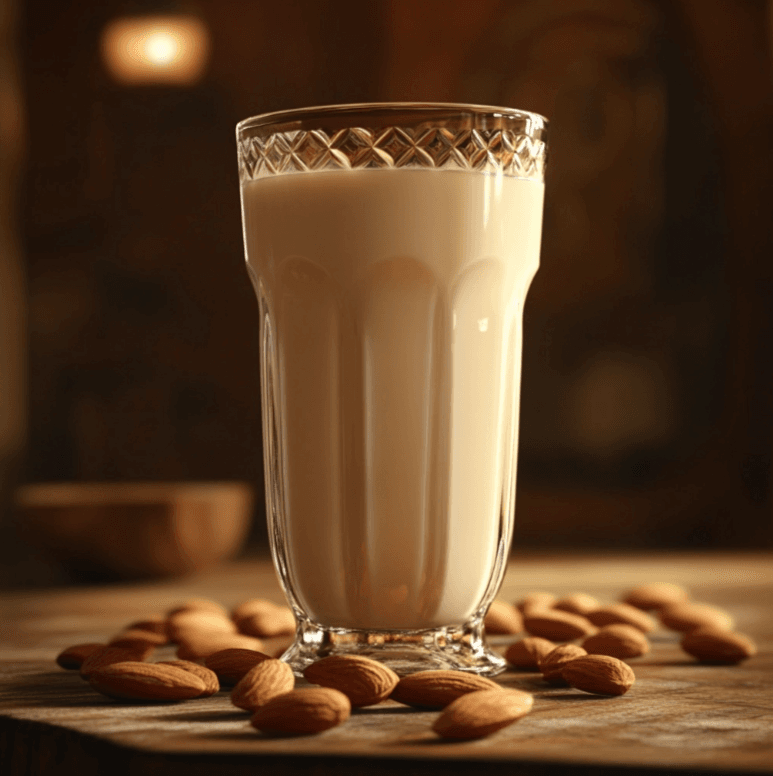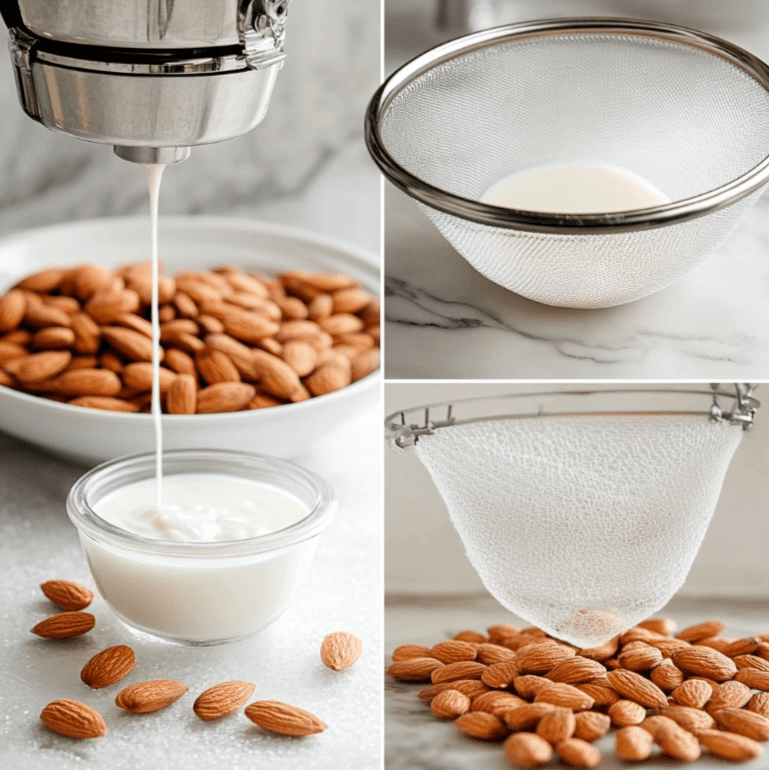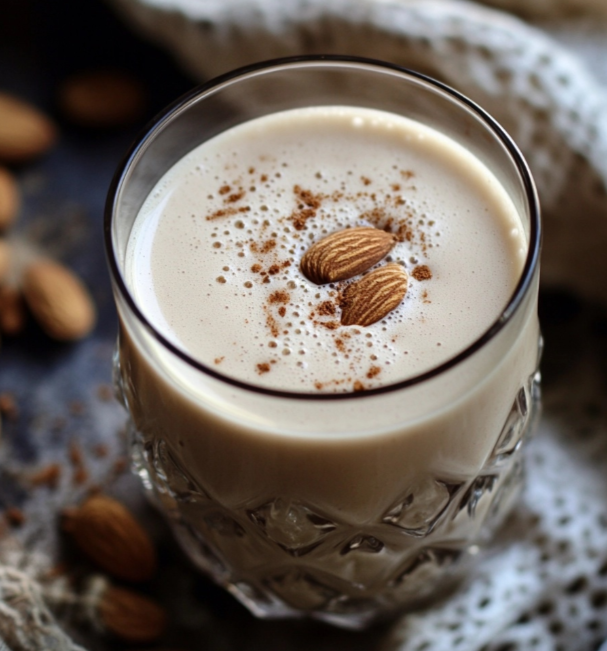If you’ve ever walked down the dairy aisle, you’ve probably noticed shelves stocked with almond milk. It’s creamy, nutty, and a favorite among health-conscious folks. But is almond milk actually good for you? How does it compare to dairy? And what are the best ways to use it?
Let’s dive into everything you need to know about almond milk—from its nutrition to common problems and how to fix them!

Table of Contents
What is Almond Milk? A Brief Introduction
Almond milk is a plant-based alternative to dairy milk, made from ground almonds and water. It has a light, slightly nutty taste and a creamy texture that makes it a popular choice for smoothies, coffee, and cooking. Unlike dairy, almond milk is naturally lactose-free, making it an excellent option for people with lactose intolerance.
The Origins and History
Would you believe that almond milk isn’t a new trend? This dairy-free milk has been around since the Middle Ages! Historical records show that it was a common ingredient in medieval European and Middle Eastern cuisine, often used in place of cow’s milk since fresh dairy spoiled quickly.
How is it Made? Traditional and Commercial Methods
There are two main ways to prepare:
- Homemade Almond Milk – Made by soaking almonds, blending them with water, and straining the mixture to remove solids.
- Commercial Almond Milk – Factory-produced almond milk includes stabilizers, preservatives, and sometimes added vitamins to enhance shelf life and nutrition.
👨🍳 Want to make your own almond milk? Don’t worry! I’ll guide you through a simple recipe later in this article.
Nutritional Value 🥛
Almond milk is well-loved for being low in calories and dairy-free, but how does it stack up nutritionally?
Almond Milk vs. Dairy Milk: A Quick Comparison
| Nutrient | Almond Milk (Unsweetened, 1 cup) | Cow’s Milk (Whole, 1 cup) |
|---|---|---|
| Calories | 30-50 kcal | 150 kcal |
| Protein | 1g | 8g |
| Carbohydrates | 1-2g | 12g |
| Fat | 2.5g | 8g |
| Calcium | 35% DV (Fortified) | 30% DV |
| Vitamin D | 25% DV (Fortified) | 20% DV |
➡️ As you can see, almond milk is lower in calories but lacks the protein found in dairy milk. However, most store-bought versions are fortified with calcium and vitamin D to match dairy’s nutritional profile.
Health Benefits 🌟
Is it just a trendy drink, or does it offer real health benefits? Let’s break it down.
1. Is Almond Milk Good for Weight Loss?
Absolutely! Almond milk is naturally low in calories, especially the unsweetened version. If you’re trying to cut back on calories, swapping cow’s milk for almond milk could help.
Quick Tip: Always check the label! Flavored almond milk (like vanilla or chocolate) often contains added sugars, which can turn this healthy drink into a sneaky calorie bomb.
2. Does Almond Milk Help with Digestion and Lactose Intolerance?
Unlike cow’s milk, almond milk contains zero lactose, making it gut-friendly for those who experience bloating or digestive issues with dairy. Plus, it’s easier to digest compared to heavy cream or whole milk.
3. Can Almond Milk Improve Skin and Hair Health?
Almonds are packed with vitamin E, a powerful antioxidant that helps keep skin glowing and hair healthy. Drinking it regularly could contribute to better skin elasticity and reduce dryness.
“Vitamin E is like sunscreen from the inside—it protects your skin from oxidative damage and keeps it youthful.”
4. Is Almond Milk Suitable for People with Diabetes?
Yes! Unsweetened almond milk is low in carbohydrates, meaning it won’t cause sharp blood sugar spikes. This makes it a smart choice for people following a low-carb or diabetic-friendly diet.
5. Does Almond Milk Strengthen Bones Like Dairy Milk?
Since almonds don’t naturally contain calcium, many almond milk brands fortify their products with calcium and vitamin D to support bone health. Be sure to choose a fortified version if bone strength is a concern!

Common Problems with Almond Milk (And How to Fix Them!) 🚨
Despite its many benefits, almond milk isn’t perfect. Here are some common issues and how to solve them.
1. Why Does Almond Milk Separate in Coffee? ☕
Ever poured it into hot coffee only to see it curdle? This happens because of the acidity and heat.
✅ Fix: Use barista-style almond milk, which contains stabilizers to prevent curdling. Alternatively, add the almond milk first and then slowly pour in the coffee.
Common Issues with Almond-Based Milk and How to Fix Them
Even though nut-based milk is a great dairy-free alternative, it does come with a few common problems. Here’s a closer look at some of the issues and how to resolve them.
2. Why Does It Taste Bitter Sometimes?
If you’ve made your own nut-based milk at home and noticed a slightly bitter flavor, the culprit is likely the almond skins. The outer layer of raw almonds contains tannins, which can cause an unpleasant taste.
✅ Solution: Always peel the almonds before blending, or use blanched almonds for a smoother, naturally sweeter result.
3. Is It Safe for Babies and Toddlers?
For infants, nut-derived milk isn’t an ideal substitute for breast milk or formula. It lacks essential nutrients, particularly protein and healthy fats, which are crucial for growth and development.
✅ Solution: Stick to breast milk or formula for babies. For toddlers, it can be consumed occasionally, but it shouldn’t replace fortified dairy or plant-based alternatives that offer a more balanced nutrient profile.
4. Why Does It Spoil Faster Than Dairy?
Homemade versions of nut milk tend to go bad more quickly than cow’s milk because they lack natural preservatives. Additionally, commercial versions contain stabilizers and pasteurization, which extend their shelf life.
✅ Solution: Store homemade versions in the fridge and consume within 3-5 days. Always shake before use, and if it smells sour or has a curdled texture, discard it immediately.
5. Can It Trigger Allergies? Who Should Avoid It?
Since almonds are classified as tree nuts, people with nut allergies should avoid consuming almond-based drinks. Reactions can range from mild discomfort to severe allergic responses.
✅ Alternative: If you have a nut allergy, consider options like oat or soy milk, which provide similar benefits without the risk of allergic reactions.
Sustainability and Environmental Impact 🌍
Plant-based milk alternatives are often praised for being eco-friendly, but how sustainable is almond-based milk compared to other options?
Water Consumption and Environmental Effects
One of the main concerns regarding almond cultivation is the high water usage. It takes approximately 1.1 gallons of water to grow just one almond. Given that California produces 80% of the world’s supply, the environmental impact is significant, especially in regions prone to drought.
➡️ Interesting Fact: Producing one glass of almond-derived milk requires 74 liters (19.5 gallons) of water, whereas dairy milk demands nearly ten times more.
While nut-based milk is water-intensive, dairy farming has an even greater environmental footprint, contributing significantly to greenhouse gas emissions and land usage.
Comparison: Which Plant-Based Milk is More Sustainable?
| Milk Type | Water Usage | Greenhouse Gas Emissions | Land Usage |
|---|---|---|---|
| Almond-Based | High | Low | Low |
| Oat-Based | Low | Very Low | Moderate |
| Soy-Based | Moderate | Low | Moderate |
| Dairy Milk | Extremely High | Very High | Very High |
🧐 Best Choice for Sustainability? If you’re looking for an eco-friendly option with lower water consumption, oat-based milk is the most sustainable choice, followed by soy-based alternatives.
How to Choose the Best Almond Milk at the Store 🛒
With so many brands on the shelves, how do you pick the healthiest, tastiest, and most nutritious almond milk?
What to Look for on the Ingredients List
Before you grab a carton, flip it over and check the ingredients. The best almond milk should have:
✅ Almonds as the first ingredient (Not just “almond base” or “almond extract”)
✅ Filtered water
✅ Fortified nutrients like calcium, vitamin D, and B12
✅ No artificial flavors or colors
Pro Tip: Many brands use thickening agents like carrageenan, which may cause digestive issues in some people. Opt for versions without it if you’re sensitive!
Unsweetened vs. Sweetened Almond Milk: Which is Better?
- Unsweetened Almond Milk: Best for health-conscious people since it’s low in calories and sugar.
- Sweetened Almond Milk: Tastes better but often contains added sugars, which can spike blood sugar levels.
✅ Verdict: Go for unsweetened almond milk to keep things healthy and versatile. If you want it sweet, just add a little honey or dates at home!
Best Almond Milk Brands: A Comparison Guide
Here are some of the most popular almond milk brands and what makes them stand out:
| Brand | Calories (Unsweetened, 1 Cup) | Fortified with Calcium & Vitamin D? | Best For |
|---|---|---|---|
| Silk Almond Milk | 30 kcal | Yes | Best overall choice |
| Califia Farms | 40 kcal | Yes | Barista-style for coffee |
| Elmhurst Almond Milk | 90 kcal | No | Cleanest ingredients |
| Alpro Almond Milk | 13 kcal | Yes | Best low-calorie option |
| Blue Diamond Almond Breeze | 30 kcal | Yes | Most affordable |
How to Make Homemade Almond Milk (Easy Recipe) 👨🍳
Store-bought almond milk is convenient, but nothing beats the fresh, creamy taste of homemade almond milk! Plus, making it yourself avoids preservatives and artificial additives.

Ingredients:
| Ingredient | Quantity |
|---|---|
| Raw almonds | 1 cup |
| Filtered water | 4 cups |
| Vanilla extract (optional) | 1 tsp |
| Sweetener (honey, dates, or maple syrup) | 1-2 tbsp |
| Pinch of salt | 1/4 tsp |
Step-by-Step Instructions:
1️⃣ Soak the Almonds: Place almonds in a bowl, cover with water, and soak overnight (or for at least 8 hours). This softens them and improves the creaminess.
2️⃣ Drain & Rinse: Drain and rinse the soaked almonds thoroughly.
3️⃣ Blend: Add almonds and 4 cups of filtered water to a high-speed blender. Blend for 60-90 seconds until creamy.
4️⃣ Strain: Pour the blended mixture through a nut milk bag, cheesecloth, or fine mesh strainer into a bowl. Squeeze out as much liquid as possible.
5️⃣ Flavor (Optional): Add vanilla extract, sweetener, or a pinch of salt for extra taste.
6️⃣ Store: Pour into a sealed glass container and refrigerate for up to 5 days. Shake before use!
Pro Tip: Don’t throw away the leftover almond pulp! Use it to make cookies, smoothies, or even homemade almond flour. ♻️
Creative Ways to Use Almond Milk in Recipes 🍽️
Plant-based milk isn’t just for drinking! It’s a fantastic alternative to dairy in both sweet and savory dishes. Whether you’re making breakfast, beverages, or desserts, here are some of the best ways to incorporate it into your meals.
1. In Coffee and Smoothies ☕
This dairy-free option can add a smooth, creamy texture to both hot and cold beverages.
✅ For Coffee & Lattes: Opt for barista-style nut milk, which is designed to froth better and prevent curdling.
✅ For Smoothies: Blend with bananas, spinach, berries, and nut butter for a nutrient-packed drink.
2. Cooking: Dairy-Free Substitutes 🍛

Nut-derived milk works well in many cooking applications, providing a light texture and subtle nutty flavor. It can replace regular milk in:
- Pancakes & Waffles 🥞 – Adds a delicate texture while keeping them dairy-free.
- Mashed Potatoes 🥔 – Use the unsweetened variety for a creamy finish.
- Soups & Sauces 🥣 – Ideal for creamy soups (like broccoli cheddar) and pasta sauces.
Pro Tip: Since nut milk has a thinner consistency than dairy, consider using cornstarch or flour as a thickening agent in soups and sauces.
3. Desserts: Vegan Ice Cream, Puddings, and More 🍰
Who says you need dairy for creamy, indulgent desserts? This plant-based alternative works wonders in sweet treats!
- Vegan Ice Cream 🍦 – Blend frozen bananas with nut milk and cocoa powder for a guilt-free dessert.
- Chia Pudding 🍮 – Mix with chia seeds, vanilla, and honey, then let it sit overnight for a nutritious snack.
- Chocolate Mug Cake 🍫 – Use this dairy-free milk instead of cow’s milk for a fluffy, rich texture.
Frequently Asked Questions About Nut-Based Milk ❓
Many people are curious about storage, usage, and best practices for this dairy alternative. Here are answers to some of the most common questions.
1. Can You Freeze It? ❄️
Yes, but freezing may change its texture, leading to separation and graininess.
✅ Best Way to Freeze:
1️⃣ Pour into ice cube trays or an airtight container.
2️⃣ Store for up to 3 months.
3️⃣ Thaw overnight in the fridge and shake well before using.
Best Use for Frozen Nut Milk: Smoothies, soups, and baking—rather than drinking it plain.
2. Is It Suitable for a Keto Diet? 🥑
Yes! The unsweetened version is low in carbs (1-2g per cup), making it perfect for keto and low-carb diets.
🚨 Avoid: Sweetened or flavored varieties, which can have 10g+ of sugar per cup.
3. How Can You Tell If It’s Expired? 🕰️
Like any milk, this dairy-free alternative has a shelf life. Here’s how to check if it has gone bad:
| Signs of Spoilage | What to Look For |
|---|---|
| Sour smell | Strong, unpleasant odor |
| Thick or lumpy texture | Should be smooth and liquid |
| Color change | Slightly yellowish or off-white |
| Odd taste | Sour or bitter instead of nutty |
✅ Storage Tip:
- Homemade versions last 3-5 days in the fridge.
- Store-bought (unopened) can last up to two weeks.
- Once opened, consume within 7-10 days.
Pro Tip: Always shake before use, as natural separation occurs.
4. Can You Heat It for Cooking? 🔥
Yes! It can be used in hot beverages, soups, and sauces. However, it may curdle if heated too quickly or combined with acidic ingredients (like coffee).
✅ How to Heat It Properly:
- Warm it slowly over low to medium heat, stirring constantly.
- Avoid boiling, as this can cause separation.
Making a latte? Choose barista-style plant-based milk, designed for better steaming and frothing.
5. Can It Be Used in Baking? 🍰
Absolutely! This dairy-free alternative can replace cow’s milk 1:1 in most baked goods.
Perfect for:
✔️ Cakes 🎂
✔️ Muffins 🧁
✔️ Pancakes 🥞
✔️ Cookies 🍪
✅ Tip: If using unsweetened nut milk, consider adding a bit of vanilla extract or a natural sweetener to match the flavor of dairy.

Final Thoughts: Should You Switch to Almond Milk? 🤔
So, should you make the switch to almond milk? That depends on your dietary needs, preferences, and environmental concerns.
✅ You should try almond milk if:
✔️ You’re lactose-intolerant or have a dairy allergy.
✔️ You want a low-calorie and low-carb milk alternative.
✔️ You’re on a vegan or plant-based diet.
✔️ You’re looking for a milk that’s rich in vitamin E and antioxidants.
🚨 You might want to avoid almond milk if:
❌ You have a nut allergy.
❌ You need a high-protein milk (opt for soy milk or pea milk instead).
❌ You’re concerned about water consumption (consider oat milk as a more sustainable choice).
➡️ Final Verdict: Almond milk is a fantastic plant-based option, but it’s not the best choice for everyone. If you love it, go for it! If not, there are plenty of other great dairy-free alternatives.
Key Takeaways 📝
✔️ Almond milk is a nutritious, dairy-free alternative that’s low in calories and rich in vitamin E.
✔️ It’s great for weight loss, digestion, and skin health but lacks the protein of dairy milk.
✔️ There are different types of almond milk (sweetened, unsweetened, barista-style). Always read the labels!
✔️ Making homemade almond milk is easy, healthier, and more natural.
✔️ It has a smaller carbon footprint than dairy, but its water consumption is a concern.
✔️ Almond milk works well in baking, cooking, smoothies, and coffee, but can sometimes curdle.
Internal Links & Related Reads
If you enjoyed this guide, check out some related articles on Yummy States:
🔗 Creamy Cauliflower Soup with White Cheddar – A perfect recipe to try with almond milk!
🔗 Ultimate Guide to the Perfect Smoked Salmon Dip – Discover another delicious dairy-free alternative for creamy dips.
🔗 Chocolate Banana Bread – Try swapping dairy milk with almond milk in this tasty dessert!

